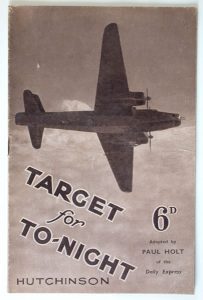The primary source item we have chosen to analyse is the illustrated book ‘Target for Tonight’. This artefact was produced after the short documentary film from 1941. It follows the Royal Air Force during the Second World War, forming a record of one particular bombing raid in Germany, so remains factual and informative concerning the events and actions that occurred for this particular mission. Published by Hutchinson & Co., this book is comprised of text and pictures which demonstrates the authenticity of the source as a documentary related piece by including visuals and description. Adapted by Paul Holt, a contributor to the Daily Express newspaper, it is easy to accept as a genuine and believable nonfiction item. However, this does not prevent the book from being entertaining as well as informative. It may have appealed to fans of the film who enjoyed the content following the soldiers and having the gritty details of World War ll revealed.

Due to the fact that it is an illustrated book of the documentary film ‘Target for Tonight’, we would think the target audience would have been individuals who were perhaps fans of the film. Fans that wanted to have access to more information surrounding the making of the documentary. We are unsure of the age range that this book aimed to reach. On the cover, it makes reference to ‘Paul Holt of the Daily Express,’ who wrote this adaptation. The connotations of someone who is part of a newspaper could imply that the target audience was perhaps twenty-five and above. However, we also discussed how a younger age range of men perhaps as young as seven, who were interested in the goings-on of the war, would also have been interested in this.
This source finds its significance in informing us about how the war affected cinema in the United Kingdom, through modelling characters on the legitimate Royal Air Force personnel, owing to a sense of realism and conforming to its documentary style genre conventions. As such, these portrayals of army personnel offer insight into the realities of war, as audiences are made to follow a narrative wrought in devastation and demise as director Harry Watt follows a military unit following a bomb raid attack. Thematically, war has the ability to suspend audience disbelief, as although throughout the time, the general public experienced the tyranny of World War II, they were not part of the front line, per say; but dealt with the aftermath at home. Thus, cinema throughout this time offered a secondary insight into the more brutal elements of war. Furthermore to group discussion, we argued that perhaps cinema during this time of dramatic social change and political upheaval, was used as a way to keep the general population informed about the then current events of the war, rather than using it for methods of escapism; as they seemed to be in a state of perpetual instability during the Second World War.
This item, unfortunately, cannot give us any insight into how the audience would have received it. We would need to research around this subject and find more information about this book, to give us more critical insight to understand its reception. Furthermore, although we understand that this artefact echoes the time during the war, we cannot, however, discern the iconography of the warplane and what it symbolises without further investigation.
TUTOR FEEDBACK
The group have selected a really interesting primary source here, one that challenged you to produce some original research to make sense of the object. The group have risen well to this challenge, and the post offers some really thoughtful detail unpacking what the booklet contains, why it might have been produced, and what it might tell us about British wartime cinema / cinema in wartime. I especially liked the speculation about its appeal for audiences, and there is some great work here setting up and testing out hypothesis about the item and its varied meanings or original uses. The post captures a clear sense of discursive activity where the group tried to make sense of and contextualise the source, and it concludes well with some thoughts about its limitations. Overall, excellent work – well done.